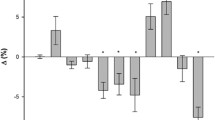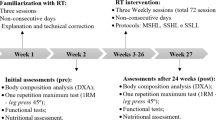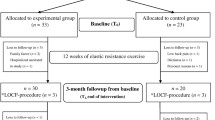Abstract
Aims
The concomitant increase in skeletal muscle mass (SMM) and decrease in fat mass has been termed body recomposition. This study aimed to analyze the influence of pre-training levels of fat mass on body recomposition, muscular strength, and (phase angle) PhA after 24 weeks of resistance training (RT) in older women.
Methods
Data from 99 older women (68.6 ± 5.7 years, 65.7 ± 8.6 kg, 155.1 ± 5.8 cm, 27.2 ± 3.1 kg/m2) was retrospectively analyzed. Participants were separated into tertiles according to the amount of fat mass at baseline as follows: low fat mass (L-FM, n = 33), moderate fat mass (M-FM, n = 33), and high fat mass (H-FM, n = 33). The participants underwent a RT program consisting of eight exercises, three sets per exercise, with a load between 8 and 15 RM, performed three times per week for 24 weeks. The SMM and fat mass were evaluated by dual-energy X-ray absorptiometry (DXA). Body recomposition was determined by the composite Z-score of changes in SMM and fat mass. One repetition maximum (1RM) tests in chest press, knee extension, and preacher curl were assessed to verify muscular strength. Bioimpedance was used to determine phase angle.
Results
Results indicated that after the RT period, a greater positive body recomposition was observed in the L-FM group than in M-FM and H-FM groups. Moreover, all groups increased muscular strength and phase angle with no significant difference among groups (P > 0.05).
Conclusion
The present study results suggest that the initial amount of fat mass influences the body recomposition induced by RT in older women, with those with lower pre-training fat mass levels presenting higher levels of body recomposition. However, improvements in muscular strength and phase angle are not dependent on the amount of initial fat mass in older women.

Similar content being viewed by others
References
Cruz-Jentoft AJ, Bahat G, Bauer J et al (2019) Sarcopenia: revised European consensus on definition and diagnosis. Age Ageing 48:16–31
Chen LK, Woo J, Assantachai P et al (2020) Asian working group for sarcopenia: 2019 consensus update on sarcopenia diagnosis and treatment. J Am Med Dir Assoc 21:300
Baumgartner RN, Wayne SJ, Waters DL et al (2004) Sarcopenic obesity predicts instrumental activities of daily living disability in the elderly. Obes Res 12:1995–2004
Gandham A, Mesinovic J, Jansons P et al (2021) Falls, fractures, and areal bone mineral density in older adults with sarcopenic obesity: a systematic review and meta-analysis. Obes Rev 22:e13187
Morgan PT, Smeuninx B, Breen L (2020) Exploring the impact of obesity on skeletal muscle function in older age. Front Nutr 7:569904
Cunha PM, Ribeiro AS, Tomeleri CM et al (2018) The effects of resistance training volume on osteosarcopenic obesity in older women. J Sports Sci 36:1564–1571
Cavalcante EF, Ribeiro AS, Nascimento MA et al (2018) Effects of different resistance training frequencies on fat in overweight/obese older women. Int J Sports Med 39:527–534
Barakat C, Pearson J, Escalante G et al (2020) Body recomposition: can trained individuals build muscle and lose fat at the same time? Strength Cond J 42:7–21
Ribeiro AS, Pereira LC, Schoenfeld BJ et al (2022) Moderate and higher protein intakes promote superior body recomposition in older women performing resistance training. Med Sci Sports Exerc 54:807–813
Nunes JP, Pina FLC, Ribeiro AS et al (2020) Responsiveness to muscle mass gain following 12 and 24 weeks of resistance training in older women. Aging Clin Exp Res 33:1071–1078
Nicklas BJ, Chmelo E, Delbono O et al (2015) Effects of resistance training with and without caloric restriction on physical function and mobility in overweight and obese older adults: a randomized controlled trial. Am J Clin Nutr 101:991–999
Pescatello LS, Kelsey BK, Price TB et al (2007) The muscle strength and size response to upper arm, unilateral resistance training among adults who are overweight and obese. J Strength Cond Res 21:307–313
Peterson MD, Liu D, Gordish-Dressman H et al (2011) Adiposity attenuates muscle quality and the adaptive response to resistance exercise in non-obese, healthy adults. Int J Obes (Lond) 35:1095–1103
Marcus RL, Addison O, LaStayo PC (2013) Intramuscular adipose tissue attenuates gains in muscle quality in older adults at high risk for falling. A brief report. J Nutr Health Aging 17:215–218
Wang X, Miller GD, Messier SP et al (2007) Knee strength maintained despite loss of lean body mass during weight loss in older obese adults with knee osteoarthritis. J Gerontol A Biol Sci Med Sci 62:866–871
Koster A, Ding J, Stenholm S et al (2011) Does the amount of fat mass predict age-related loss of lean mass, muscle strength, and muscle quality in older adults? J Gerontol A Biol Sci Med Sci 66:888–895
Zoico E, Di Francesco V, Guralnik JM et al (2004) Physical disability and muscular strength in relation to obesity and different body composition indexes in a sample of healthy elderly women. Int J Obes Relat Metab Disord 28:234–241
Vilaça KH, Carneiro JA, Ferriolli E et al (2014) Body composition, physical performance and muscle quality of active elderly women. Arch Gerontol Geriatr 59:44–48
Hilton TN, Tuttle LJ, Bohnert KL et al (2008) Excessive adipose tissue infiltration in skeletal muscle in individuals with obesity, diabetes mellitus, and peripheral neuropathy: association with performance and function. Phys Ther 88:1336–1344
Argilés JM, López-Soriano J, Almendro V et al (2005) Cross-talk between skeletal muscle and adipose tissue: a link with obesity? Med Res Rev 25:49–65
Schaap LA, Pluijm SM, Deeg DJ et al (2006) Inflammatory markers and loss of muscle mass (sarcopenia) and strength. Am J Med 119:526
Visser M, Pahor M, Taaffe DR et al (2002) Relationship of interleukin-6 and tumor necrosis factor-alpha with muscle mass and muscle strength in elderly men and women: the Health ABC Study. J Gerontol A Biol Sci Med Sci 57:M326–M332
Webster JM, Kempen L, Hardy RS et al (2020) Inflammation and skeletal muscle wasting during cachexia. Front Physiol 11:597675
Bosy-Westphal A, Danielzik S, Dörhöfer RP et al (2006) Phase angle from bioelectrical impedance analysis: population reference values by age, sex, and body mass index. JPEN J Parenter Enteral Nutr 30:309–316
Norman K, Stobäus N, Pirlich M et al (2012) Bioelectrical phase angle and impedance vector analysis–clinical relevance and applicability of impedance parameters. Clin Nutr 31:854–861
Sardinha LB (2018) Physiology of exercise and phase angle: another look at BIA. Eur J Clin Nutr 72:1323–1327
Tomeleri CM, Cavalcante EF, Antunes M et al (2019) Phase angle is moderately associated with muscle quality and functional capacity, independent of age and body composition in older women. J Geriatr Phys Ther 42:281–286
Stobäus N, Pirlich M, Valentini L et al (2012) Determinants of bioelectrical phase angle in disease. Br J Nutr 107:1217–1220
Tomeleri CM, Cavaglieri CR, de Souza MF et al (2017) Phase angle is related with inflammatory and oxidative stress biomarkers in older women. Exp Gerontol 102:12–18
Norman K, Wirth R, Neubauer M et al (2015) The bioimpedance phase angle predicts low muscle strength, impaired quality of life, and increased mortality in old patients with cancer. J Am Med Dir Assoc 16:173
Wilhelm-Leen ER, Hall YN, Horwitz RI et al (2014) Phase angle, frailty and mortality in older adults. J Gen Intern Med 29:147–154
Lukaski HC, Kyle UG, Kondrup J (2017) Assessment of adult malnutrition and prognosis with bioelectrical impedance analysis: phase angle and impedance ratio. Curr Opin Clin Nutr Metab Care 20:330–339
Sardinha LB, Lohman TG, Teixeira PJ et al (1998) Comparison of air displacement plethysmography with dual-energy X-ray absorptiometry and 3 field methods for estimating body composition in middle-aged men. Am J Clin Nutr 68:786–793
Souza MF, Tomeleri CM, Ribeiro AS et al (2017) Effect of resistance training on phase angle in older women: a randomized controlled trial. Scand J Med Sci Sports 27:1308–1316
Harttig U, Haubrock J, Knüppel S et al (2011) The MSM program: web-based statistics package for estimating usual dietary intake using the Multiple Source Method. Eur J Clin Nutr 65:S87–S91
Fragala MS, Cadore EL, Dorgo S et al (2019) Resistance training for older adults: position statement from the national strength and conditioning association. J Strength Cond Res 33:2019–2052
ACSM (2009) American College of Sports Medicine position stand. Progression models in resistance training for healthy adults. Med Sci Sports Exerc 41:687–708
Hall KD, Heymsfield SB, Kemnitz JW et al (2012) Energy balance and its components: implications for body weight regulation. Am J Clin Nutr 95:989–994
Hunter GR, Wetzstein CJ, Fields DA et al (2000) Resistance training increases total energy expenditure and free-living physical activity in older adults. J Appl Physiol 89:977–984
Wewege MA, Desai I, Honey C et al (2021) The effect of resistance training in healthy adults on body fat percentage, fat mass and visceral fat: a systematic review and meta-analysis. Sports Med 52:287–300
Wackerhage H, Schoenfeld BJ, Hamilton DL et al (2019) Stimuli and sensors that initiate skeletal muscle hypertrophy following resistance exercise. J Appl Physiol 126:30–43
Slater GJ, Dieter BP, Marsh DJ et al (2019) Is an energy surplus required to maximize skeletal muscle hypertrophy associated with resistance training. Front Nutr 6:131
Pérez LM, Pareja-Galeano H, Sanchis-Gomar F et al (2016) Adipaging: ageing and obesity share biological hallmarks related to a dysfunctional adipose tissue. J Physiol 594:3187–3207
Ferrucci L, Fabbri E (2018) Inflammageing: chronic inflammation in ageing, cardiovascular disease, and frailty. Nat Rev Cardiol 15:505–522
Shokri-Mashhadi N, Moradi S, Heidari Z et al (2021) Association of circulating C-reactive protein and high-sensitivity C-reactive protein with components of sarcopenia: a systematic review and meta-analysis of observational studies. Exp Gerontol 150:111330
Peterson MD, Sen A, Gordon PM (2011) Influence of resistance exercise on lean body mass in aging adults: a meta-analysis. Med Sci Sports Exerc 43:249–258
Grgic J, Garofolini A, Orazem J et al (2020) Effects of resistance training on muscle size and strength in very elderly adults: a systematic review and meta-analysis of randomized controlled trials. Sports Med 50:1983–1999
Ribeiro AS, Schoenfeld BJ, Souza MF et al (2017) Resistance training prescription with different load-management methods improves phase angle in older women. Eur J Sport Sci 17:913–921
Ribeiro AS, Schoenfeld BJ, Dos Santos L et al (2020) Resistance training improves a cellular health parameter in obese older women: a randomized controlled trial. J Strength Cond Res 34:2996–3002
Acknowledgments
The authors thank all subjects for their engagement in the study, the Coordination of Improvement of Higher Education Personnel (CAPES/ Brazil) for the scholarship conferred to W. K. (master), and the National Council of Technological and Scientific Development (CNPq/Brazil) for the grants conceded to E. S. C. This work was partially supported by the Ministry of Education (MEC/Brazil) and CNPq/Brazil.
Author information
Authors and Affiliations
Corresponding author
Ethics declarations
Conflict of interest
The authors declare that they have no conflict of interest regarding the publication of this paper.
Ethical statement
The investigation was performed according to principles outlined in the Declaration of Helsinki and was approved by the local University Ethics Committee.
Informed consent
All participants were informed of the procedures and signed a written informed consent to participate in the study.
Additional information
Publisher's Note
Springer Nature remains neutral with regard to jurisdictional claims in published maps and institutional affiliations.
Rights and permissions
Springer Nature or its licensor (e.g. a society or other partner) holds exclusive rights to this article under a publishing agreement with the author(s) or other rightsholder(s); author self-archiving of the accepted manuscript version of this article is solely governed by the terms of such publishing agreement and applicable law.
About this article
Cite this article
Ribeiro, A.S., Oliveira, A.V., Kassiano, W. et al. Effects of resistance training on body recomposition, muscular strength, and phase angle in older women with different fat mass levels. Aging Clin Exp Res 35, 303–310 (2023). https://doi.org/10.1007/s40520-022-02313-7
Received:
Accepted:
Published:
Issue Date:
DOI: https://doi.org/10.1007/s40520-022-02313-7




